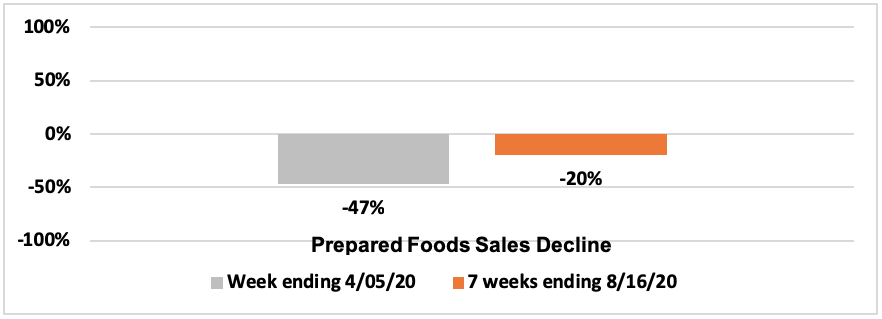Staying Prepared
Retail foodservice growth was slowing prior to the pandemic,[1] but shopper trip decline[2] and its impact on shrink[3], as well as the closure of hot and cold bars and grocerants have resulted in unimaginable losses. Reports have been bleak, with Prepared Foods sales declines of -47% in early April, rising to only -20% as of mid-August.[4]

Reversing this trend is difficult, as it can’t be solved merely through increased foot traffic. The Covid-era, fatigued home cook — coping via takeout and delivery — actually needs deli to behave more like a restaurant, rather than a grocerant…one that competes not only on convenience, but also on variety and personalization. Here’s why:
Variety
At present, 9 in 10 retail foodservice shoppers are dissatisfied with the assortment, demanding “more new items and flavors”[5] — especially new global items and flavors — as evidenced by their actual restaurant delivery behavior. In the first half of 2020, Grubhub’s five highest growth items were all global cuisine:
| Rank | Highest Delivery Growth First Half 2020 | % Growth |
|---|---|---|
| 1 | Rigatoni Bolognese | +292 |
| 2 | Lamb Vindaloo | +283 |
| 3 | Vegetable Korma | +267 |
| 4 | Moo Shu Pork | +266 |
| 5 | Salmon Avocado Roll | +244 |
But, we know that global items will not singlehandedly restore retail foodservice sales. Assortment issues are larger than that. Analysts paint a picture of a shopper seeking variety in not just flavors, but sizes[6] and occasions as well. The reality of three at-home meals per day requires retailers to take a fresh look at assortment from all angles: single households, larger families, breakfast, lunch, dinner and snack. To that end, we see sales demonstrate that sides, breakfast items and prepared meats have all achieved growth, while traditional categories like hot and cold bars, entrees, soups, salads, sandwiches and pizza have declined.[7]
Personalization
In the future, all signs point to hyper-customization. Food as Medicine will lead to prescriptive meals for personal health, robots will be capable of quickly producing a high volume of meals with different ingredients,[8] artificial intelligence will mine behavior and baskets to make real-time recommendations,[9] mobile apps will facilitate custom entrées available for pickup or delivery,[10] and shoppers will be willing to pay more.[11] In this environment, retail foodservice must master the art of “made to order”.
Yet, with all of the complexities and unmet needs above, we believe the greatest threat to retail foodservice manufacturers is a shift in partners. Retailers committed to improving assortment, personalization and community are forging prepared meals partnerships with area restaurants. Emerging examples include everything from H-E-B meal kits by award-winning chefs in San Antonio and Houston,[12] to SpartanNash’s heat-and-serve offerings from fifteen Michigan-area restaurants[13] to ghost kitchen-esque Eat Street food trucks embedded within Minneapolis’ Lunds & Byerlys deli departments.[14]
So, what are Prepared meals manufacturers to do? While introducing new, craveable proteins and sides that better compete with local restaurants is a no-brainer for the manufacturer, shrink-weary retailers aren’t always willing to take on the new and unproven. So, we turned to our in-house culinary expert (and former-life Deli Manager), Chef Dan Follese for a few suggestions:
- Create multiple forms out of a single protein, e.g., converting rotisserie chicken into prepared, pulled chicken, for an equally simple center-of-plate option, but one that paves the way for totally different sides and accompaniments.
- Help store departments work together to drive meal solutions…treating the store like a pantry. Say your featured foodservice item is a Rigatoni Bolognese…now imagine staff trained and empowered with the ability to recommend the perfect accompaniments: a prepared mozzarella and tomato salad in the cold section, an individual Tiramisu in the bakery…even a bottle of wine in the liquor store that complements the sauce.
- Consider partnering with a retailer’s approved vendors to create mutual meal solutions…or even to create LTOs, e.g., spice packets or mix-ins that help consumers personalize their takeout.
In summary, behaving like a restaurant isn’t only about convenience, variety and personalization, but about finding creative ways to work with what already exists in-house.
[1] “Decision Drivers in Supermarket Prepared Foods”, Progressive Grocer, 2/13/20
[2] “Perimeter sales patterns continue holding steady, suggesting new normal”, Supermarket Perimeter, 9/02/20
[3] “Beating the shrink on grocery shelves”, McKinsey & Company, 9/20
[4] “Foodservice Recovery: Reviving the perimeter’s biggest revenue stream”, Supermarket Perimeter, 10/04/20
[5] “Decision Drivers in Supermarket Prepared Foods”, Progressive Grocer, 2/13/20
[6] “How grocers are filling the mealtime void during the pandemic”, GroceryDive, 4/27/20
[7] “What’s Driving Perimeter Sales Now”, Winsight Grocery Business, 10/13/20
[8] “The Food Store of the Future”, Winsight Grocery, 1/09/20
[9] “Netflix-style discovery platform developed for retail: Why has this not happened in food?”, Food Navigator, 1/20/20
[10] “How the pandemic could fundamentally order store layouts”, GroceryDive, 6/08/20
[11] “How retailers can maximize grab-and-go demand in-store and online”, GroceryDive, 9/28/20
[12] “Consumers are cooking at home more, but some are getting tired of it”, Grocery Dive, 9/16/20
[13] “SpartanNash Announces Partnerships to Support Restaurants”, Deli Market News, 4/28/20
[14] “Lunds & Byerlys Goes Pop-Up With Food Trucks”, Winsight Grocery Business, 9/29/20
